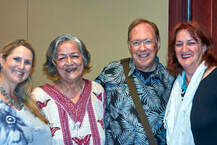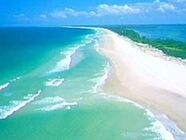We have POSTPONED the 2020 Australian Tour of Lee Carrol and Kryon.
As of 18th August, we have notified everyone who had purchased tickets advising of a refund.
If you have not received your message, please email [email protected]
As of 18th August, we have notified everyone who had purchased tickets advising of a refund.
If you have not received your message, please email [email protected]
POSTPONED
|

Join Lee Carroll, Monika Muranyi, and special guest Auntie Minnie Mace on this full day excursion to Bribie Island.
The Wisdom of Kryon is often described as ancient knowledge from the indigenous given in a modern language, which is why this excursion gives you the best of both worlds.
The day will be filled with deep insights from Aboriginal Elder Auntie Minnie, profound teachings from Lee and Monika, and there will be a channelled message from Kryon. This intimate tour will be accompanied with snacks and drinks, as well as lunch and is sure to create a treasured memory of a family gathering.
The Wisdom of Kryon is often described as ancient knowledge from the indigenous given in a modern language, which is why this excursion gives you the best of both worlds.
The day will be filled with deep insights from Aboriginal Elder Auntie Minnie, profound teachings from Lee and Monika, and there will be a channelled message from Kryon. This intimate tour will be accompanied with snacks and drinks, as well as lunch and is sure to create a treasured memory of a family gathering.
Cultural Introduction by Auntie Minnie Mace
Culture is the outward expression of our inner spiritual growth, be in collective or individual.
Here’s an example of knowledge aboriginal people have always had. Aboriginal women when about to give birth would go to a sacred birthing site and give birth with the aid of a midwife or second wife. If the child was a girl they would map out, on a piece of bark, the star constellations directly overhead at the time of the birth. When that girl reached her childbearing years she would be given the piece of bark and told, this is your “coming-down time”. This was used to determine her time of ovulation. (Obviously, this was not done for boy babies as they don't ovulate!).
If you spend some time gazing at the stars sky you will see 2 wheels, one moving clockwise and one moving anti-clockwise. It takes a full month for the stars to move back around to exactly the same position. When the stars are in the exact same position as when the girl was born, that will indicate her ovulation time. If she conceives during the first week past that time it will likely be a girl, if during the second week then a boy. As it was common for men to have several wives, this became evidence of whose turn it was to sleep with the husband.
You may wonder what would happen if the sky was overcast on the day a child was born? A few months after being asked that question I was sleeping out at the base of Mount Beerwah, one of the Glasshouse Mountains, with a few other women and a dozen teenage girls, all in sleeping bags in a line with a minder at each end. There was a huge lightning storm covering an area of around 100 sq miles centered around the mountain. No rain fell as there was a hole in the cloud mass over Mount Beerwah. This got me thinking...
Mount Beerwah is composed of igneous rock, which holds the heat of the sun. At night the heat rises and parts the clouds. That is why Mt Beerwah and other rock monoliths such as Uluru have been identified as sacred birthing centres. It is in those places that there is always a clear view of the stars.
It is interesting that a woman’s body temperature rises during ovulation as can be proven by using a simple pharmacy thermometer. When fertility begins, heat rises.
The Great Botany Bay Debate is the different theories held by historians, as to the reasons, why the British came to Australia. One theory is based on the need to lay claim to this Country before the French, because La Fayette was believed to be preparing to claim this country, for France. The British wanted to prevent this, by claiming it first. Another theory was based on a need to send the growing population of convicts here, as the convict ships anchored on the Thames River were overflowing, boosted by men returning from the Napoleonic Wars. But, why send them all the way to Australia when Britain already had large landholdings in Africa which was closer to Britain?
So they were sent here for strategic purposes. But in the differing arguments put forward, nowhere was it mentioned that the shipping company that gained to make a huge profit was in fact owned by Members of the House of Lords, in the British Parliament.
When the First Fleet arrived, there was at the very least 600 different tribal dialects. Tri-annual gatherings were held where the food source was plentiful. This enabled our People to come together to trade. Wood from the western desert made good boomerangs, as the timber wouldn't warp. Black Palmwood from the northern rain forest made the best spears. Shell from the coastal areas made good tools, as well as decorative items. Although the different languages provided barriers in communicating. The Corroboree, a dance festival, helped transcend any language barriers.
Here’s an example of knowledge aboriginal people have always had. Aboriginal women when about to give birth would go to a sacred birthing site and give birth with the aid of a midwife or second wife. If the child was a girl they would map out, on a piece of bark, the star constellations directly overhead at the time of the birth. When that girl reached her childbearing years she would be given the piece of bark and told, this is your “coming-down time”. This was used to determine her time of ovulation. (Obviously, this was not done for boy babies as they don't ovulate!).
If you spend some time gazing at the stars sky you will see 2 wheels, one moving clockwise and one moving anti-clockwise. It takes a full month for the stars to move back around to exactly the same position. When the stars are in the exact same position as when the girl was born, that will indicate her ovulation time. If she conceives during the first week past that time it will likely be a girl, if during the second week then a boy. As it was common for men to have several wives, this became evidence of whose turn it was to sleep with the husband.
You may wonder what would happen if the sky was overcast on the day a child was born? A few months after being asked that question I was sleeping out at the base of Mount Beerwah, one of the Glasshouse Mountains, with a few other women and a dozen teenage girls, all in sleeping bags in a line with a minder at each end. There was a huge lightning storm covering an area of around 100 sq miles centered around the mountain. No rain fell as there was a hole in the cloud mass over Mount Beerwah. This got me thinking...
Mount Beerwah is composed of igneous rock, which holds the heat of the sun. At night the heat rises and parts the clouds. That is why Mt Beerwah and other rock monoliths such as Uluru have been identified as sacred birthing centres. It is in those places that there is always a clear view of the stars.
It is interesting that a woman’s body temperature rises during ovulation as can be proven by using a simple pharmacy thermometer. When fertility begins, heat rises.
The Great Botany Bay Debate is the different theories held by historians, as to the reasons, why the British came to Australia. One theory is based on the need to lay claim to this Country before the French, because La Fayette was believed to be preparing to claim this country, for France. The British wanted to prevent this, by claiming it first. Another theory was based on a need to send the growing population of convicts here, as the convict ships anchored on the Thames River were overflowing, boosted by men returning from the Napoleonic Wars. But, why send them all the way to Australia when Britain already had large landholdings in Africa which was closer to Britain?
So they were sent here for strategic purposes. But in the differing arguments put forward, nowhere was it mentioned that the shipping company that gained to make a huge profit was in fact owned by Members of the House of Lords, in the British Parliament.
When the First Fleet arrived, there was at the very least 600 different tribal dialects. Tri-annual gatherings were held where the food source was plentiful. This enabled our People to come together to trade. Wood from the western desert made good boomerangs, as the timber wouldn't warp. Black Palmwood from the northern rain forest made the best spears. Shell from the coastal areas made good tools, as well as decorative items. Although the different languages provided barriers in communicating. The Corroboree, a dance festival, helped transcend any language barriers.

A brief history of Bribie Island by Auntie Minnie Mace
Bribie Island is a one hour drive north of Brisbane Airport. It is the only Island which is accessible by Bridge. Bribie Island is one of a larger Group of Sand Islands, registered under 'World Heritage Listing.' Only the Sourthern tip of Bribie Island is populated, the other 27 kilometers is used as a Pine Tree plantation, with the remainder being a Wildlife Reserve.
Many books have been written about Bribie Island and how it got its name. But they are all wrong. The collective thought is that Bribie was a Convict. Well, he was, but his name wasn't Bribie. He was a Convict who used to weave baskets to catch Mud Crabs with. He'd get a ticket of Leave from Brisbane, then come to the Island and if he overstayed his Leave time. He would use the Crabs to bribe the guards to avoid punishment. Hence, it was called Bribie Island, his name was actually Hamilton and he worked on the road gang building a road along the Brisbane River. This road runs along the Brisbane River through a suburb named Hamilton after him. Hamilton had a love affair with an aboriginal woman, who remains unnamed and who sadly passed away during child birth. The child was named Kalmakuta and was reared by the Westaway Family of Caloundra. She was given an English name, Alma. She married, Fred Turner, the son of an English Doctor who migrated to Australia in the late 1800's. My very good friend Daphne Dux is the Great Grand Daughter of Alma and Fred Turner. On the mainland, just before the Bridge stands a monument to Kalmakuta, for the rescue of many many people after their boat ran aground on Sandbanks in and around the Bribie passage.
The Explorer Mathew Flinders landed on Bribie Island back when he circumnavigated Australia, at the time one of the Natives of the Joondiburri Tribe, touched Captain Flinders triangular shaped hat, and was immediately shot dead on the spot. As you drive over the Bridge connecting Bribie Island to the Mainland, a spectacular view of the Glasshouse Mountains appears to the left. During Mathew Flinders visit to Bribie Island, he and a number of crew members left the Ship Anchored off Sandstone Point and set off overland on foot. His journey overland would have had him and his selected Crew members battling plagues of biting insects.
Their overland journey came to an end a few kilometers short of reaching the base of Mt Tibrogargan. A Memorial Park honouring the endurance of Flinders and his Crew during this dangerous expedition, has been erected on Steve Irwin Way.
Bribie Island is a one hour drive north of Brisbane Airport. It is the only Island which is accessible by Bridge. Bribie Island is one of a larger Group of Sand Islands, registered under 'World Heritage Listing.' Only the Sourthern tip of Bribie Island is populated, the other 27 kilometers is used as a Pine Tree plantation, with the remainder being a Wildlife Reserve.
Many books have been written about Bribie Island and how it got its name. But they are all wrong. The collective thought is that Bribie was a Convict. Well, he was, but his name wasn't Bribie. He was a Convict who used to weave baskets to catch Mud Crabs with. He'd get a ticket of Leave from Brisbane, then come to the Island and if he overstayed his Leave time. He would use the Crabs to bribe the guards to avoid punishment. Hence, it was called Bribie Island, his name was actually Hamilton and he worked on the road gang building a road along the Brisbane River. This road runs along the Brisbane River through a suburb named Hamilton after him. Hamilton had a love affair with an aboriginal woman, who remains unnamed and who sadly passed away during child birth. The child was named Kalmakuta and was reared by the Westaway Family of Caloundra. She was given an English name, Alma. She married, Fred Turner, the son of an English Doctor who migrated to Australia in the late 1800's. My very good friend Daphne Dux is the Great Grand Daughter of Alma and Fred Turner. On the mainland, just before the Bridge stands a monument to Kalmakuta, for the rescue of many many people after their boat ran aground on Sandbanks in and around the Bribie passage.
The Explorer Mathew Flinders landed on Bribie Island back when he circumnavigated Australia, at the time one of the Natives of the Joondiburri Tribe, touched Captain Flinders triangular shaped hat, and was immediately shot dead on the spot. As you drive over the Bridge connecting Bribie Island to the Mainland, a spectacular view of the Glasshouse Mountains appears to the left. During Mathew Flinders visit to Bribie Island, he and a number of crew members left the Ship Anchored off Sandstone Point and set off overland on foot. His journey overland would have had him and his selected Crew members battling plagues of biting insects.
Their overland journey came to an end a few kilometers short of reaching the base of Mt Tibrogargan. A Memorial Park honouring the endurance of Flinders and his Crew during this dangerous expedition, has been erected on Steve Irwin Way.


